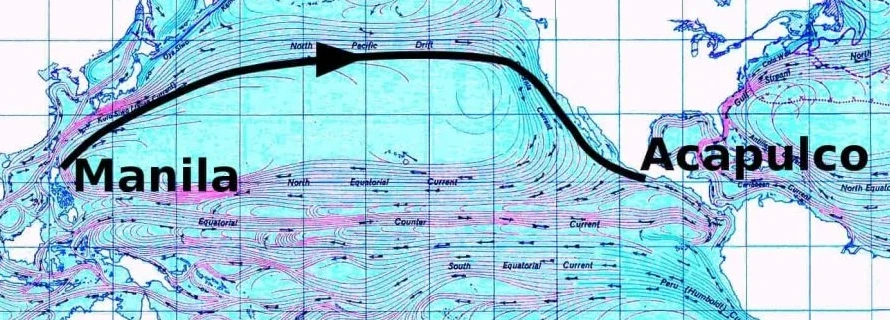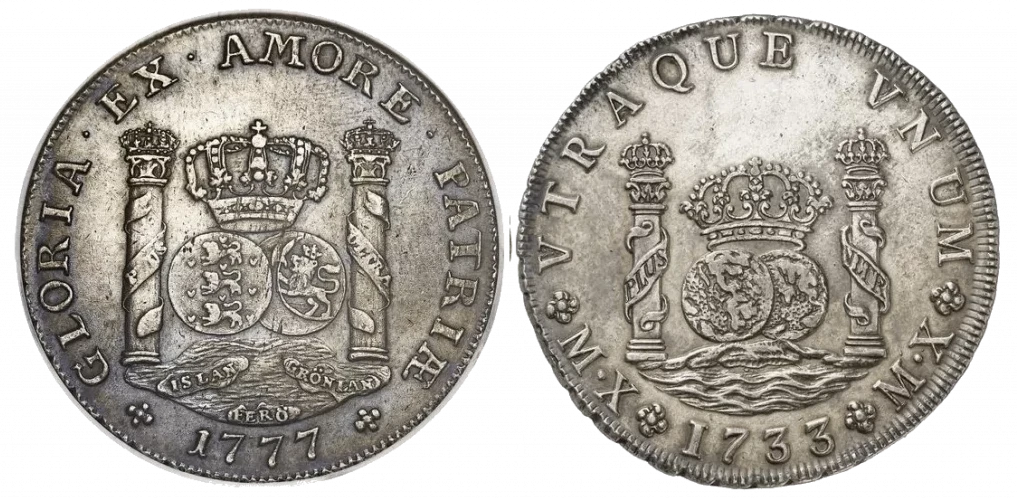The Pillar Dollar is the quintessential colonial coin and one of the most iconic coins in world numismatics. One of the reasons for this is the importance it gained as the first globally accepted currency. However, Denmark resisted depending on the Pillar Dollar and took another route: it would make its own. This is the story of the Greenland Dollar.
Trade with China
The West began trading with China back in the 16th century. But one of the problems European merchants encountered upon arrival was that the Chinese rulers were only interested in silver. They didn’t want any other goods, just silver.
The Spanish Empire was fortunate because, in its colonial possessions, there was silver in abundance. The mines of America, with Potosí at the forefront, were producing most of the world’s silver.
And with that silver, Spain made coins. Many of them. And they used them to pay for things all over the world. The so-called “Manila Galleon,” which was a regular trade route that carried silver to the Philippines and brought goods to America, was one of the pillars of the imperial economy. The silver that arrived in the Philippines then went to China.

The economic power of the Empire in the 16th century was so great that the Spanish 8 reales coin became the first globally recognized and accepted currency.
The Pillar Dollar
The 8 reales coin had been minted since the 16th century, during the time of the Catholic Monarchs, so it has many different designs. However, the most well-known design—by far—is the Pillar Dollar, named after the colonial coat of arms that appears on the reverse.

It was minted in different mints in Latin America from 1732 to 1773 and soon became the preferred method of payment throughout China. Given two coins of equal silver content, a Chinese merchant would always accept a Pillar Dollar over any other coin, simply due to the prestige associated with this piece.
The other powers had no choice but to adopt the 8 reales and countermark it, thus placing a barrier to the independence of their Asian trade, which to some extent came to depend on the Spanish Empire. By the way, this is the origin of trade dollars, which we will discuss in another entry very soon.
Seeing the situation, instead of countermarking the 8 reales coins to identify their origin without losing prestige, Denmark chose another path: they were going to make their own Pillar Dollar.
The Greenland Dollar
The name “Greenland Dollar” is somewhat misleading. In reality, this coin was not minted to circulate there, but in the Far East. However, it is one of the few Danish coins that include the names of what were Denmark’s island territories at that time: Greenland, the Faroe Islands, and Iceland.
Officially, the denomination of the Greenland Dollar is 1 piastre. It appears with two minting dates, 1771 and 1777, under the reign of Christian VII. However, the 1771 coin was actually minted in 1774, the year when the Danish Asiatic Company ceded the rights for commercial exploitation of the Far East to the Kingdom of Denmark.

According to the Salvesen catalog, which is the one cited by Heritage whenever one of these is auctioned, a total of 44,900 pieces were minted, but only between 20 and 22 specimens remain in total, of which 12 are in museums. The hammer price of the last three Greenland Dollars auctioned (all three in 2018) was $96,000, $90,000, and $76,000. Quite a sum.

This coin has two varieties. In the KM#639.1 variety, the name of Iceland is written as “ISLAND.” In the 1777 version (KM#639.2), however, it appears as “ISLAN.”
Differences between the Greenland Dollar and the Pillar Dollar
If you place the Greenland Dollar and the Pillar Dollar side by side, you have to look closely to see the differences. And you see them because you understand the Latin alphabet. Imagine if you were a Chinese person in the 18th century and all your life you had only seen Chinese characters. They would easily fool you, no doubt. It even has the “PLVS ULTRA”, which was the Spanish state motto at the time.

Basically, on the reverse of both coins, there are only four differences:
- The names of Iceland, Greenland, and the Faroe Islands are introduced in the sea.
- On the globes, the world spheres are replaced by the coat of arms of Denmark.
- There is a small size difference. The Greenland Dollar weighs 26.98 grams and measures 39.6 mm, while the Pillar Dollar weighs 27.07 grams and measures 40 mm.
- The famous “UTRAQUE UNUM” of the Pillar Dollar is replaced by the Danish motto in Latin “GLORIA EX AMORE PATRIÆ”, which means “the love of the homeland is my reward.”
On the obverse, the coat of arms of Denmark is different, but it is also designed to resemble as closely as possible that of the Spanish monarchs, adding another layer of “deception.”
The Pillar Dollar is the colonial coin par excellence and one of the most iconic coins in world numismatics. And there is a reason for that: if you add to the spectacular reverse design the importance it gained as the first global currency, the result is that there are very few numismatics enthusiasts who do not have or want one.
And I’ll tell you, after writing this article, now I want two.